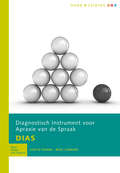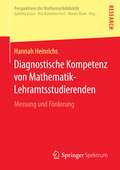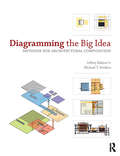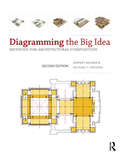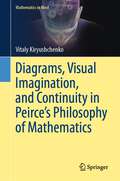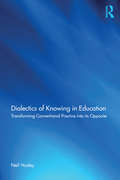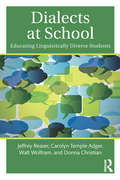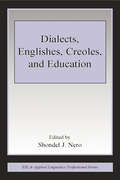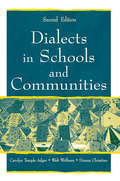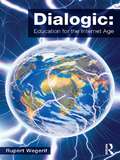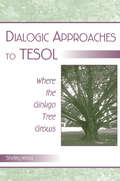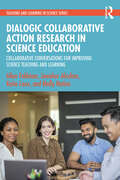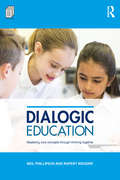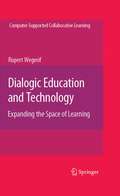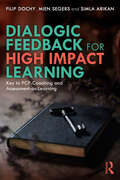- Table View
- List View
Diagnostisch Instrument voor Apraxie van de Spraak (DIAS) handleiding
by Judith Feiken Roel JonkersDoel van de testHet Diagnostisch Instrument voor Apraxie van de Spraak (DIAS) is een instrument waarmee de diagnose ‘spraakapraxie’ gesteld wordt. Daarnaast kan met het DIAS de ernst van de spraakapraxie worden bepaald. Het DIAS is het eerste betrouwbare en gestandaardiseerde instrument voor het specifiek diagnosticeren van spraakapraxie, los van eventueel aanwezige andere stoornissen, zoals afasie en / of dysartrie. Met de test legt men een goede basis voor een passend therapieplan voor de patientgroep met spraakapraxie en het instrument brengt het effect in kaart van specifiek op spraakapraxie gerichte therapie. Het DIAS onderzoekt de aard van de spraakapraxie door na te gaan welke specifieke symptomen van de stoornis aanwezig zijn en in welke mate. Daarnaast bepaalt het instrument het niveau van de doelbewuste articulatie, waarmee de ernst van de spraakapraxie in kaart wordt gebracht. Met het DIAS onderzoekt men patiënten bij wie een vermoeden bestaat dat er sprake is van spraakapraxie of waarbij al is vastgesteld dat er sprake is van spraakapraxie. Het instrument is geschikt om af te nemen aan het eind van de acute fase en bij de aanvang van de revalidatiefase. Om logopedische therapie te kunnen evalueren wordt geadviseerd het DIAS met tussenpozen van 3 maanden af te nemen en de uitkomsten van de afnamen te vergelijken.Toepassing• Diagnose: stelt de diagnose spraakapraxie en bepaalt de ernst van de stoornis.• Differentiaaldiagnose: onderscheidt spraakapraxie van afasie en dysartrie.• Behandeling: helpt bij het maken van een passend therapieplan.• Evaluatie: bepaalt het effect van gegeven therapie• Onderzoek: levert een bijdrage aan o.a. therapie- effectstudiesWat meet het DIAS?Het DIAS bevat vier taken, gericht op de articulatorisch- motorische programmering:1. aansturing van de articulatiespieren, los van de spraak (buccofaciaal)2. bewuste articulatie van individuele klanken3. diadochokinese (afwisselen van articulatieplaats en -wijze)4. articulatie van woorden met een toenemende articulatiecomplexiteitMet deze vier taken worden de specifieke kenmerken van de spraakapraxie en de ernst van stoornis vastgesteld.Voor wie?Het DIAS kan worden afgenomen zonder specifieke kennis over de achtergronden van spraakapraxie. Scoring en interpretatie mogen echter alleen worden uitgevoerd door professionals die deze kennis wel hebben. Afname en scoringAlle taken van het DIAS worden op multimodale (mondeling en schriftelijk) wijze aangeboden. Dit heeft als doel de invloed van eventueel aanwezige fatische stoornissen zoveel mogelijk te vermijden. De afname verloopt in een vaste volgorde, bij voorkeur achter elkaar door en duurt 30 tot 45 minuten. Elke afname wordt opgenomen op video en achteraf gescoord.NormenDe diagnose spraakapraxie wordt gesteld op basis van een cutoff-score met betrekking tot het aantal aanwezige kenmerken in combinatie met de aanwezigheid van combinaties van specifieke kenmerken. De interpretatie van de ernstscores wordt uitgevoerd met behulp van normtabellen. Er kan een vergelijking worden gemaakt met de scores van patiënten met spraakapraxie (percentielen) en met de scores van mensen zonder spraakstoornis (gemiddelden).Materialen• Diagnostisch Instrument voor Apraxie van de Spraak (DIAS) — complete set • Diagnostisch Instrument voor Apraxie van de Spraak (DIAS) — scoreformulieren (25)• Diagnostisch Instrument voor Apraxie van de Spraak (DIAS) — handleiding
Diagnostische Kompetenz von Mathematik-Lehramtsstudierenden: Messung und Förderung (Perspektiven der Mathematikdidaktik)
by Hannah HeinrichsVor dem Hintergrund der aktuellen Diskussion zur Lehrerprofessionalität geht Hannah Heinrichs der Frage nach, wie diagnostische Kompetenzen von (angehenden) Lehrkräften effektiv gefördert werden können. Die Autorin konzentriert sich dabei auf die fehlerdiagnostische Kompetenz von Mathematik-Lehramtsstudierenden und untersucht, wie sich bereits in der ersten Phase der Lehrerbildung der Umgang mit Schülerfehlern, ihre schnelle Identifikation, ihre zielgerichtete Interpretation und die Entwicklung angemessener Handlungsalternativen fördern lassen. Sie zeigt, dass sich die fehlerdiagnostische Kompetenz der Studierenden durch eine universitäre Lehrveranstaltung positiv beeinflussen lässt.
Diagramming the Big Idea: Methods for Architectural Composition
by Jeffrey Balmer Michael T. SwisherAs a beginning design student, you need to learn to think like a designer, to visualize ideas and concepts, as well as objects. In Diagramming the Big Idea, Jeffrey Balmer and Michael T. Swisher illustrate how you can create and use diagrams to clarify your understanding of both particular projects and organizing principles and ideas. With accessible, step-by-step exercises that interweave diagrams, drawings and virtual models, the authors clearly show you how to compose meaningful and useful diagrams. As you follow the development of the four project groups drawn from the authors’ teaching, you will become familiar with architectural composition concepts such as proportion, site, form, hierarchy and spatial construction. In addition, description and demonstration essays extend concepts to show you more examples of the methods used in the projects. Whether preparing for a desk critique, or any time when a fundamental insight can help to resolve a design problem, this book is your essential studio resource.
Diagramming the Big Idea: Methods for Architectural Composition
by Jeffrey Balmer Michael T. SwisherAs a beginning design student, you need to learn to think like a designer, to visualize ideas and concepts, as well as objects. In Diagramming the Big Idea, Jeffrey Balmer and Michael T. Swisher illustrate how you can create and use diagrams to clarify your understanding of both particular projects and organizing principles and ideas. With accessible, step-by-step exercises that interweave diagrams, drawings and virtual models, the authors clearly show you how to compose meaningful and useful diagrams. As you follow the development of the four project groups drawn from the authors’ teaching, you will become familiar with architectural composition concepts such as proportion, site, form, hierarchy and spatial construction. In addition, description and demonstration essays extend concepts to show you more examples of the methods used in the projects. Whether preparing for a desk critique, or any time when a fundamental insight can help to resolve a design problem, this book is your essential studio resource.
Diagramming the Big Idea: Methods for Architectural Composition
by Jeffrey Balmer Michael T. SwisherBecoming an architect is a daunting task. Beyond the acquisition of new skills and procedures, beginning designers face an entirely unfamiliar mode of knowledge: design thinking. In Diagramming the Big Idea, Jeffrey Balmer and Michael T. Swisher introduce the fundamentals of design thinking by illustrating how architects make and use diagrams to clarify their understanding of both specific architectural projects and universal principles of form and order. With accessible, step-by-step procedures that interweave diagrams, drawings and virtual models, the authors demonstrate how to compose clear and revealing diagrams. Design thinking defines a method for engaging the world through observation and analysis. Beyond problem solving, design is a search for possibilities. Mastering design thinking begins with learning the fundamentals of visual composition. It embraces the ability to synthesize deductive and imaginative reasoning, combining both shrewd scrutiny and fevered speculation. Design diagrams make visible the abstractions that order the built environment. Premised upon the Beaux-Arts notion of the architectural parti, Balmer and Swisher adopt the ‘Big Idea’ as a foil and as a suitcase to organize fundamentals of architectural composition. The goal of this book is to make explicit to students what they are learning, why they are learning it and how to internalize such lessons toward their lifelong development as designers.
Diagramming the Big Idea: Methods for Architectural Composition
by Jeffrey Balmer Michael T. SwisherBecoming an architect is a daunting task. Beyond the acquisition of new skills and procedures, beginning designers face an entirely unfamiliar mode of knowledge: design thinking. In Diagramming the Big Idea, Jeffrey Balmer and Michael T. Swisher introduce the fundamentals of design thinking by illustrating how architects make and use diagrams to clarify their understanding of both specific architectural projects and universal principles of form and order. With accessible, step-by-step procedures that interweave diagrams, drawings and virtual models, the authors demonstrate how to compose clear and revealing diagrams. Design thinking defines a method for engaging the world through observation and analysis. Beyond problem solving, design is a search for possibilities. Mastering design thinking begins with learning the fundamentals of visual composition. It embraces the ability to synthesize deductive and imaginative reasoning, combining both shrewd scrutiny and fevered speculation. Design diagrams make visible the abstractions that order the built environment. Premised upon the Beaux-Arts notion of the architectural parti, Balmer and Swisher adopt the ‘Big Idea’ as a foil and as a suitcase to organize fundamentals of architectural composition. The goal of this book is to make explicit to students what they are learning, why they are learning it and how to internalize such lessons toward their lifelong development as designers.
Diagrams, Visual Imagination, and Continuity in Peirce's Philosophy of Mathematics (Mathematics in Mind)
by Vitaly KiryushchenkoThis book is about the relationship between necessary reasoning and visual experience in Charles S. Peirce’s mathematical philosophy. It presents mathematics as a science that presupposes a special imaginative connection between our responsiveness to reasons and our most fundamental perceptual intuitions about space and time. Central to this view on the nature of mathematics is Peirce’s idea of diagrammatic reasoning. In practicing this kind of reasoning, one treats diagrams not simply as external auxiliary tools, but rather as immediate visualizations of the very process of the reasoning itself. Thus conceived, one's capacity to diagram their thought reveals a set of characteristics common to ordinary language, visual perception, and necessary mathematical reasoning. The book offers an original synthetic approach that allows tracing the roots of Peirce’s conception of a diagram in certain patterns of interrelation between his semiotics, his pragmaticist philosophy, his logical and mathematical ideas, bits and pieces of his biography, his personal intellectual predispositions, and his scientific practice as an applied mathematician.
Dialectics of Knowing in Education: Transforming Conventional Practice into its Opposite
by Neil HooleyDialectics of Knowing in Education strengthens the philosophical basis of formal education that has been weakened by neoliberalism over the past 30 years. It theorises and encourages human existence based on social action, culture, inquiry and creativity so that citizens in democratic association can formulate their own understandings of the world and be their own philosophers of practice. Under neoliberal capitalism, formal education has become a key economic driver and factor for all countries, but has exacerbated social division and inequality. This has led to an increased pressure on education systems to emphasise individual gain and prosperity at the expense of community care and concern. Drawing on the work of Dewey, Mead, Freire and Biesta, the author argues that formal education at all levels must be transformed so that it does not seek to impose knowledge and truth, but situates knowledge as being constructed by democratic learning circles of staff, students and citizens. Focusing particularly on the notion of praxis and specific issues involving Indigenous, feminist and practitioner knowing, this book will help scholars, practitioners and policy makers to transform their education theories and practices in ways that encourage democracy, emancipation, social action, culture, inquiry and creativity.
Dialectics of Knowing in Education: Transforming Conventional Practice into its Opposite
by Neil HooleyDialectics of Knowing in Education strengthens the philosophical basis of formal education that has been weakened by neoliberalism over the past 30 years. It theorises and encourages human existence based on social action, culture, inquiry and creativity so that citizens in democratic association can formulate their own understandings of the world and be their own philosophers of practice. Under neoliberal capitalism, formal education has become a key economic driver and factor for all countries, but has exacerbated social division and inequality. This has led to an increased pressure on education systems to emphasise individual gain and prosperity at the expense of community care and concern. Drawing on the work of Dewey, Mead, Freire and Biesta, the author argues that formal education at all levels must be transformed so that it does not seek to impose knowledge and truth, but situates knowledge as being constructed by democratic learning circles of staff, students and citizens. Focusing particularly on the notion of praxis and specific issues involving Indigenous, feminist and practitioner knowing, this book will help scholars, practitioners and policy makers to transform their education theories and practices in ways that encourage democracy, emancipation, social action, culture, inquiry and creativity.
Dialects at School: Educating Linguistically Diverse Students
by Jeffrey Reaser Carolyn Temple Adger Walt Wolfram Donna ChristianLike its predecessor, Dialects in Schools and Communities, this book illuminates major language-related issues that educational practitioners confront, such as responding to dialect related features in students’ speech and writing, teaching Standard English, teaching students about dialects, and distinguishing dialect difference from language disorders. It approaches these issues from a practical perspective rooted in sociolinguistic research, with a focus on the research base for accommodating dialect differences in schools. Expanded coverage includes research on teaching and learning and attention to English language learners. All chapters include essential information about language variation, language attitudes, and principles of handling dialect differences in schools; classroom-based samples illustrating the application of these principles; and an annotated resources list for further reading. The text is supported by a Companion Website (www.routledge.com/cw/Reaser) providing additional resources including activities, discussion questions, and audio/visual enhancements that illustrate important information and/or pedagogical approaches. Comprehensive and authoritative, Dialects at School reflects both the relevant research bases in linguistics and education and educational practices concerning language variation. The problems and examples included are authentic, coming from the authors’ own research, observations and interactions in public school classrooms, and feedback in workshops. Highlights include chapters on oral language and reading and writing in dialectally diverse classrooms, as well as a chapter on language awareness for students, offering a clear and compelling overview of how teachers can inspire students to learn more about language variation, including their own community language patterns. An inventory of dialect features in the Appendix organizes and expands on the structural descriptions presented in the chapters.
Dialects at School: Educating Linguistically Diverse Students
by Jeffrey Reaser Carolyn Temple Adger Walt Wolfram Donna ChristianLike its predecessor, Dialects in Schools and Communities, this book illuminates major language-related issues that educational practitioners confront, such as responding to dialect related features in students’ speech and writing, teaching Standard English, teaching students about dialects, and distinguishing dialect difference from language disorders. It approaches these issues from a practical perspective rooted in sociolinguistic research, with a focus on the research base for accommodating dialect differences in schools. Expanded coverage includes research on teaching and learning and attention to English language learners. All chapters include essential information about language variation, language attitudes, and principles of handling dialect differences in schools; classroom-based samples illustrating the application of these principles; and an annotated resources list for further reading. The text is supported by a Companion Website (www.routledge.com/cw/Reaser) providing additional resources including activities, discussion questions, and audio/visual enhancements that illustrate important information and/or pedagogical approaches. Comprehensive and authoritative, Dialects at School reflects both the relevant research bases in linguistics and education and educational practices concerning language variation. The problems and examples included are authentic, coming from the authors’ own research, observations and interactions in public school classrooms, and feedback in workshops. Highlights include chapters on oral language and reading and writing in dialectally diverse classrooms, as well as a chapter on language awareness for students, offering a clear and compelling overview of how teachers can inspire students to learn more about language variation, including their own community language patterns. An inventory of dialect features in the Appendix organizes and expands on the structural descriptions presented in the chapters.
Dialects, Englishes, Creoles, and Education (ESL & Applied Linguistics Professional Series)
by Shondel J. NeroThis volume brings together a multiplicity of voices--both theoretical and practical--on the complex politics, challenges, and strategies of educating students--in North America and worldwide--who are speakers of diverse or nonstandard varieties of English, creoles, and hybrid varieties of English, such as African American Vernacular English, Caribbean Creole English, Tex Mex, West African Pidgin English, and Indian English, among others. The number of such students is increasing as a result of the spread of English, internal and global migration, and increased educational access. Dialects, Englishes, Creoles, and Education offers:*a sociohistorical perspective on language spread and variation;*analysis of related issues such as language attitudes, identities, and prescribed versus actual language use; and*practical suggestions for pedagogy.Pedagogical features: Key points at the beginning of each chapter help focus the reader and provide a framework for reading, writing, reflection, and discussion; chapter-end questions for discussion and reflective writing engage and challenge the ideas presented and encourage a range of approaches in dealing with language diversity. Collectively, the chapters in this volume invite educators, researchers, and students, across the fields of TESOL, applied linguistics, sociolinguistics, English, literacy, and language education, to begin to consider and adopt context-specific policies and practices that will improve the language development and academic performance of linguistically diverse students.
Dialects, Englishes, Creoles, and Education (ESL & Applied Linguistics Professional Series)
by Shondel J. NeroThis volume brings together a multiplicity of voices--both theoretical and practical--on the complex politics, challenges, and strategies of educating students--in North America and worldwide--who are speakers of diverse or nonstandard varieties of English, creoles, and hybrid varieties of English, such as African American Vernacular English, Caribbean Creole English, Tex Mex, West African Pidgin English, and Indian English, among others. The number of such students is increasing as a result of the spread of English, internal and global migration, and increased educational access. Dialects, Englishes, Creoles, and Education offers:*a sociohistorical perspective on language spread and variation;*analysis of related issues such as language attitudes, identities, and prescribed versus actual language use; and*practical suggestions for pedagogy.Pedagogical features: Key points at the beginning of each chapter help focus the reader and provide a framework for reading, writing, reflection, and discussion; chapter-end questions for discussion and reflective writing engage and challenge the ideas presented and encourage a range of approaches in dealing with language diversity. Collectively, the chapters in this volume invite educators, researchers, and students, across the fields of TESOL, applied linguistics, sociolinguistics, English, literacy, and language education, to begin to consider and adopt context-specific policies and practices that will improve the language development and academic performance of linguistically diverse students.
Dialects in Schools and Communities
by Carolyn Temple Adger Walt Wolfram Donna ChristianThis book describes dialect differences in American English and their impact on education and everyday life. It explores some of the major issues that confront educational practitioners and suggests what practitioners can do to recognize students’ language abilities, support their language development, and expand their knowledge about dialects. Topics addressed include:*popular concerns about the nature of language variation;*characteristic structures of different dialects;*various interactive patterns characteristic of social groups;*the school impacts of dialect differences in speaking, writing, and reading, including questions about teaching Standard English; and*the value of dialect education in schools to enable students to understand dialects as natural and normal language phenomena. Changes in the Second Edition: In this edition the authors reconsider and expand their discussion of many of the issues addressed in the first edition and in other of their earlier works, taking into account especially the research on dialects and publications for audiences beyond linguistics that have appeared since the first edition. This edition is offered as an updated report on the state of language variation and education in the United States. Dialects in Schools and Communities is rooted in questions that have arisen in workshops, surveys, classes, discussion groups, and conversations with practitioners and teacher educators. It is thus intended to address important needs in a range of educational and related service fields. As an overview of current empirical research, it synthesizes current understandings and provides key references—in this sense it is a kind of translation and interpretation in which the authors’ goal is to bring together the practical concerns of educators and the vantage point of sociolinguistics. No background in linguistics or sociolinguistics is assumed on the part of the reader. This volume is intended for teacher interns and practicing teachers in elementary and secondary schools; early childhood specialists; specialists in reading and writing; speech/language pathologists; special education teachers; and students in various language specialties.
Dialects in Schools and Communities
by Carolyn Temple Adger Walt Wolfram Donna ChristianThis book describes dialect differences in American English and their impact on education and everyday life. It explores some of the major issues that confront educational practitioners and suggests what practitioners can do to recognize students’ language abilities, support their language development, and expand their knowledge about dialects. Topics addressed include:*popular concerns about the nature of language variation;*characteristic structures of different dialects;*various interactive patterns characteristic of social groups;*the school impacts of dialect differences in speaking, writing, and reading, including questions about teaching Standard English; and*the value of dialect education in schools to enable students to understand dialects as natural and normal language phenomena. Changes in the Second Edition: In this edition the authors reconsider and expand their discussion of many of the issues addressed in the first edition and in other of their earlier works, taking into account especially the research on dialects and publications for audiences beyond linguistics that have appeared since the first edition. This edition is offered as an updated report on the state of language variation and education in the United States. Dialects in Schools and Communities is rooted in questions that have arisen in workshops, surveys, classes, discussion groups, and conversations with practitioners and teacher educators. It is thus intended to address important needs in a range of educational and related service fields. As an overview of current empirical research, it synthesizes current understandings and provides key references—in this sense it is a kind of translation and interpretation in which the authors’ goal is to bring together the practical concerns of educators and the vantage point of sociolinguistics. No background in linguistics or sociolinguistics is assumed on the part of the reader. This volume is intended for teacher interns and practicing teachers in elementary and secondary schools; early childhood specialists; specialists in reading and writing; speech/language pathologists; special education teachers; and students in various language specialties.
Dialogic: Education For The Internet Age
by Rupert WegerifDialogic: Education for the Internet Age argues that despite rapid advances in communications technology, most teaching still relies on traditional approaches to education, built upon the logic of print, and dependent on the notion that there is a single true representation of reality. In practice, the use of the Internet disrupts this traditional logic of education by offering an experience of knowledge as participatory and multiple. This new logic of education is dialogic and characterises education as learning to learn, think and thrive in the context of working with multiple perspectives and ultimate uncertainty. The book builds upon the simple contrast between observing dialogue from an outside point of view, and participating in a dialogue from the inside, before pinpointing an essential feature of dialogic: the gap or difference between voices in dialogue which is understood as an irreducible source of meaning. Each chapter of the book applies this dialogic thinking to a specific challenge facing education, re-thinking the challenge and revealing a new theory of education. Areas covered in the book include: dialogical learning and cognition dialogical learning and emotional intelligence educational technology, dialogic ‘spaces’ and consciousness global dialogue and global citizenship dialogic theories of science and maths education The challenge identified in Wegerif’s text is the growing need to develop a new understanding of education that holds the potential to transform educational policy and pedagogy in order to meet the realities of the digital age. Dialogic: Education for the Internet Age draws upon the latest research in dialogic theory, creativity and technology, and is essential reading for advanced students and researchers in educational psychology, technology and policy.
Dialogic: Education For The Digital Age
by Rupert WegerifDialogic: Education for the Internet Age argues that despite rapid advances in communications technology, most teaching still relies on traditional approaches to education, built upon the logic of print, and dependent on the notion that there is a single true representation of reality. In practice, the use of the Internet disrupts this traditional logic of education by offering an experience of knowledge as participatory and multiple. This new logic of education is dialogic and characterises education as learning to learn, think and thrive in the context of working with multiple perspectives and ultimate uncertainty. The book builds upon the simple contrast between observing dialogue from an outside point of view, and participating in a dialogue from the inside, before pinpointing an essential feature of dialogic: the gap or difference between voices in dialogue which is understood as an irreducible source of meaning. Each chapter of the book applies this dialogic thinking to a specific challenge facing education, re-thinking the challenge and revealing a new theory of education. Areas covered in the book include: dialogical learning and cognition dialogical learning and emotional intelligence educational technology, dialogic ‘spaces’ and consciousness global dialogue and global citizenship dialogic theories of science and maths education The challenge identified in Wegerif’s text is the growing need to develop a new understanding of education that holds the potential to transform educational policy and pedagogy in order to meet the realities of the digital age. Dialogic: Education for the Internet Age draws upon the latest research in dialogic theory, creativity and technology, and is essential reading for advanced students and researchers in educational psychology, technology and policy.
Dialogic Approaches to TESOL: Where the Ginkgo Tree Grows
by Shelley WongThis book locates dialogic pedagogy within the history of TESOL approaches and methods in which the communicative approach has been the dominant paradigm. Dialogic inquiry in the form of story telling, oral histories, and knowledge from the ground up and from the margins has much to offer the field. In dialogic approaches, the teacher and students learn in community and the students' home languages and cultures, their families and communities, are seen as resources.Dialogic Approaches to TESOL: Where the Ginkgo Tree Grows explores teacher research, feminist contributions to voice, social identity and dialogic pedagogy, and the role of teachers, students, families, and communities as advocates and change agents. After a brief history of TESOL methods and an introduction to dialogic pedagogy, four features of dialogic approaches to TESOL are identified and discussed: learning in community, problem-posing, learning by doing, and who does knowledge serve? The main text in each chapter considers a single topic related to the concept of dialogic pedagogy. Branching text leads to related discussions without losing the main point of the chapter. This structure allows readers to become well-rooted in each component of dialogic pedagogy and to "branch out" into deeper philosophic understandings as well as actual practices across a range of contexts.Dialogic Approaches to TESOL offers a place for dialogue and reflection on the prospects for transforming educational institutions to serve those who have historically been excluded and marginalized. It provides questions, frameworks, and resources for those who are just beginning in the field and for U.S.-based educators who want to bring critical multicultural and multilingual perspectives into language arts, reading and literacy education.
Dialogic Approaches to TESOL: Where the Ginkgo Tree Grows
by Shelley WongThis book locates dialogic pedagogy within the history of TESOL approaches and methods in which the communicative approach has been the dominant paradigm. Dialogic inquiry in the form of story telling, oral histories, and knowledge from the ground up and from the margins has much to offer the field. In dialogic approaches, the teacher and students learn in community and the students' home languages and cultures, their families and communities, are seen as resources.Dialogic Approaches to TESOL: Where the Ginkgo Tree Grows explores teacher research, feminist contributions to voice, social identity and dialogic pedagogy, and the role of teachers, students, families, and communities as advocates and change agents. After a brief history of TESOL methods and an introduction to dialogic pedagogy, four features of dialogic approaches to TESOL are identified and discussed: learning in community, problem-posing, learning by doing, and who does knowledge serve? The main text in each chapter considers a single topic related to the concept of dialogic pedagogy. Branching text leads to related discussions without losing the main point of the chapter. This structure allows readers to become well-rooted in each component of dialogic pedagogy and to "branch out" into deeper philosophic understandings as well as actual practices across a range of contexts.Dialogic Approaches to TESOL offers a place for dialogue and reflection on the prospects for transforming educational institutions to serve those who have historically been excluded and marginalized. It provides questions, frameworks, and resources for those who are just beginning in the field and for U.S.-based educators who want to bring critical multicultural and multilingual perspectives into language arts, reading and literacy education.
Dialogic Collaborative Action Research in Science Education: Collaborative Conversations for Improving Science Teaching and Learning (ISSN)
by Allan Feldman Jawaher Alsultan Katie Laux Molly NationThis engaging and practical book offers science teacher educators and K-12 science teachers alike the tools to engage in a dialogic mode of collaborative action research (D-CAR), a collaborative mode of action research focused on teachers’ experiences with students, reflection upon these experiences, and peer learning.Renowned science educator Allan Feldman and co-authors from across numerous settings in K-12 science education present the theory, methodology, case studies, and practical advice to support the use of D-CAR as a means to enhance teachers’ normal practice and address the problems, dilemmas, and dissonances that science teachers must negotiate as they work to meet the needs of an increasingly diverse student population and engage with complex science teaching challenges that disproportionately affect marginalized students.The book will be of use to science teacher educators, pre-service and in-service science teachers, professional development specialists, or any science educator invested in developing creative, reflective, and thoughtful teachers.
Dialogic Collaborative Action Research in Science Education: Collaborative Conversations for Improving Science Teaching and Learning (ISSN)
by Allan Feldman Jawaher Alsultan Katie Laux Molly NationThis engaging and practical book offers science teacher educators and K-12 science teachers alike the tools to engage in a dialogic mode of collaborative action research (D-CAR), a collaborative mode of action research focused on teachers’ experiences with students, reflection upon these experiences, and peer learning.Renowned science educator Allan Feldman and co-authors from across numerous settings in K-12 science education present the theory, methodology, case studies, and practical advice to support the use of D-CAR as a means to enhance teachers’ normal practice and address the problems, dilemmas, and dissonances that science teachers must negotiate as they work to meet the needs of an increasingly diverse student population and engage with complex science teaching challenges that disproportionately affect marginalized students.The book will be of use to science teacher educators, pre-service and in-service science teachers, professional development specialists, or any science educator invested in developing creative, reflective, and thoughtful teachers.
Dialogic Education: Mastering core concepts through thinking together
by Neil Phillipson Rupert WegerifDialogue has long been used in primary classrooms to stimulate thinking, but it is not always easy to unite the creative thinking of good dialogue with the need for children to understand the core concepts behind knowledge-rich subjects. A sound understanding of key concepts is essential to progress through the national curriculum, and assessment of this understanding along with effective feedback is central to good practice. Dialogic Education builds upon decades of practical classroom research to offer a method of teaching that applies the power of dialogue to achieving conceptual mastery. Easy-to-follow template lesson plans and activity ideas are provided, each of which has been tried and tested in classrooms and is known to succeed. Providing a structure for engaging children and creating an environment in which dialogue can flourish, this book is separated into three parts: Establishing a classroom culture of learning; Core concepts across the curriculum; Wider dialogues: Educational adventures in the conversation of mankind. Written to support all those in the field of primary education, this book will be an essential resource for student, trainee and qualified primary teachers interested in the educational importance of dialogue.
Dialogic Education: Mastering core concepts through thinking together (Computer-supported Collaborative Learning Ser. #7)
by Neil Phillipson Rupert WegerifDialogue has long been used in primary classrooms to stimulate thinking, but it is not always easy to unite the creative thinking of good dialogue with the need for children to understand the core concepts behind knowledge-rich subjects. A sound understanding of key concepts is essential to progress through the national curriculum, and assessment of this understanding along with effective feedback is central to good practice. Dialogic Education builds upon decades of practical classroom research to offer a method of teaching that applies the power of dialogue to achieving conceptual mastery. Easy-to-follow template lesson plans and activity ideas are provided, each of which has been tried and tested in classrooms and is known to succeed. Providing a structure for engaging children and creating an environment in which dialogue can flourish, this book is separated into three parts: Establishing a classroom culture of learning; Core concepts across the curriculum; Wider dialogues: Educational adventures in the conversation of mankind. Written to support all those in the field of primary education, this book will be an essential resource for student, trainee and qualified primary teachers interested in the educational importance of dialogue.
Dialogic Education and Technology: Expanding the Space of Learning (Computer-Supported Collaborative Learning Series #7)
by Rupert WegerifThis book empowers people to go beyond themselves into new spheres of learning, thinking and creativity. Drawing on recent work in communications theory as well as psychology, computer science and philosophy, it reveals some key characteristics of learning dialogues. It also demonstrates ways in which computers and networks can deepen, enrich and expand such dialogues. The book’s central argument is that this dialogic perspective in education and the latest developments in information and communications technology make ideal partners.
Dialogic Feedback for High Impact Learning: Key to PCP-Coaching and Assessment-as-Learning
by Filip Dochy Mien Segers Simla ArikanIn recent years, the transmission paradigm of learning and teaching is making way for new approaches fuelled in part by the technology and AI revolutions. Learning is seen now more often in the light of connectivism, collaboration and creative problem solving. Dialogic Feedback for High Impact Learning explores this fascinating trend championing learning as a dialogic process between learners and coaches where learning is connecting networks and resources and leads to creative problem solving. It addresses the need for feedback as a dialogue in training for tomorrow, what it entails and how you can best deal with it. The book explores the power of feedback in a high-impact learning setting, where all parties strive for a learning and feedback culture rather than a consumption and testing culture. The authors discuss the feedback process, feedback seeking behaviour and the quality of the feedback message, sharing tips for software and apps to support this process and how teachers and coaches from a variety of settings have integrated the feedback dialogue into their training. This book is intended for everyone who wants to contribute to the learning culture of tomorrow, including learning coaches, managers, education and training professionals, and teachers and trainees at all levels in education.
